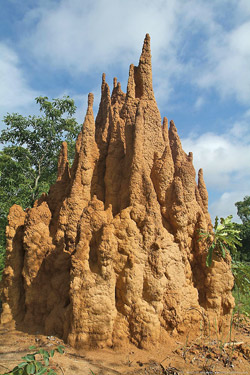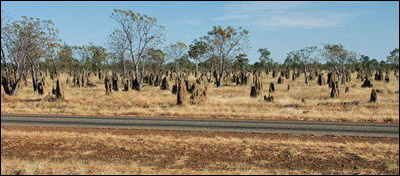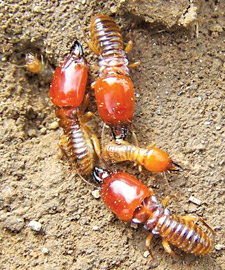|
[Nature trail - Termites]
Ant-like insects
|

Castle-like termite mound.
|
Termites. Some of you may be familiar with these ant like creatures
which are sometimes referred to as ‘white ants.’ But they are not
closely related to true ants.
These small insects that have been around for millions of years are a
group of eusocial insects that live in colonies. A typical colony
contains nymphs (semi-mature young), workers, soldiers and reproductive
individuals of both genders, sometimes comprising several egg laying
queens.
There are also king termites... Worker termites undertake the tasks
of foraging, food storage, brood and nest maintenance and some defence
duties in certain species. They are the main caste in the colony.
Termites are generally grouped according to their feeding behaviour.
Some of them are subterranean, soil-feeding, drywood, dampwood and
grass-eating termites.They are found in many parts of the world, but in
countries such as Africa and Australia they are found in large numbers.
The mounds they build are enormous.
Let’s check out some interesting facts about these ant-like insects
that are considered a pest because some species destroy many wooden
structures.
 Are there termite cities? Are there termite cities?
Yes, but they are definitely not like the ‘cities’ we live in. Many
species of termites in the tropical dry savannas build very high mounds
where they live and work. These magnetic termite mounds can be 3.5m (11
ft) high. Would you believe that the Macrotermes in Africa build mounds
that are about 7.5m (24 ft) high - that is about four times the height
of a human. But in contrast some species make their nests entirely
within one plant and even underground. These are very small. So, when
termites build such mounds and nests in large areas, they are known as
termite cities.
Who helps termites digest their food?
There are many wood-eating termites, but they do not actually digest
the wood themselves. They rely on protozoa (single-celled animals) that
live in their gut to break it down. Similarly large colonies of bacteria
that live in the gut of other termites help break down food. There are
also bacteria that take nitrogen from the air and turn it into
body-building protein. Termites owe a lot to these tiny creatures in
their guts.
What is a termite garden?
 As we explained, there are many species of termites. Some species of
termites, including Macrotermes farms or grow a fungus. They are known
to make special ‘fungus combs’ out of their own faeces and this is used
as a base to grow the fungus. These are called termite gardens. The
fungus breaks down the faeces and the termites feed on the fungus and
its products. As we explained, there are many species of termites. Some species of
termites, including Macrotermes farms or grow a fungus. They are known
to make special ‘fungus combs’ out of their own faeces and this is used
as a base to grow the fungus. These are called termite gardens. The
fungus breaks down the faeces and the termites feed on the fungus and
its products.
This fungus is special because it is only found growing in termite
nests.
Are there magnetic termite nests?
Yes. There are magnetic termites that live in Australia. They are
known to build a nest in a flat blade shape with the flat sides pointing
east and west. This brings in the cooler, morning and evening sunbeams,
but as only the narrow edge points north, only a little of the sunbeams,
when its hottest at noon, gets in.
The nest is often used as a compass by people in the bush. This is
how the nest ended up being called magnetic nests.
Do termites have ‘soldiers’ like ants do?
  As termites too live in colonies, there are soldier termites which
are tougher than the worker termites. Many species of termites are known
to have soldier termites with huge armoured heads and powerful jaws that
are used to bite off enemies, especially ants. As termites too live in colonies, there are soldier termites which
are tougher than the worker termites. Many species of termites are known
to have soldier termites with huge armoured heads and powerful jaws that
are used to bite off enemies, especially ants.
There are some species of termites that have soldier termites with
special ‘snouts’ that are capable of shooting sticky fluid over an
enemy. However, these ‘tough’ soldier termites are designed only for
fighting and so they cannot even feed themselves. They have to depend on
the workers to provide food for them.
There are some termite species that do not have soldiers to protect
them. It is the workers who take over the task of protecting and
defending the nest from enemies or predators. There are ‘suicide
bombers’ instead of soldier termites. These worker ‘bombers’ protect the
colony from enemy ants by bursting their guts open and spilling the
slimy contents over the attacking ants. They kill themselves to protect
the colony.
Fast facts
* The cap-shaped roof of the African forest termite’s mound helps
keep the rain away from the mound.
* Macrotermes build a hollow nest with a central chimney and side
channels to allow the circulation of air.
* The queen termites only job is to lay eggs and she becomes huge.
Once her huge abdomen is filled with eggs, she lays thousands of eggs.
In some species the queen lays up to 30,000 eggs a day!
* Millions of termites live in the tropics. There may be as many as
4,000 per square metre (3,300 per square yard) or twice this amount.
* The weight of termites in a square kilometre (0.4 square mile)
under the ground is more than the weight of all the zebras and elephants
feeding on the vegetation above the ground.
* They are great recyclers of plant materials. |

